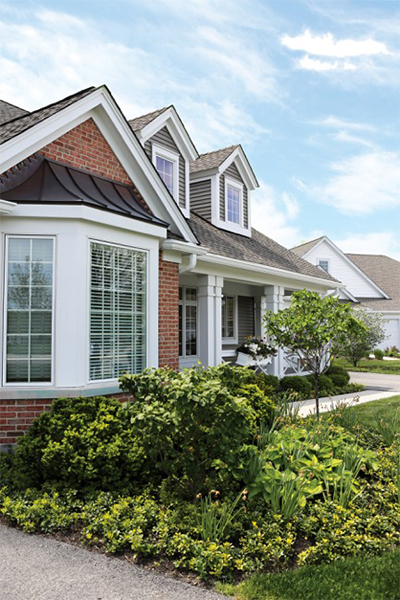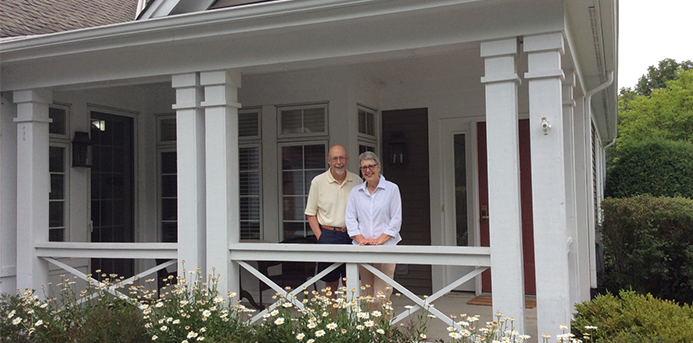Dave and Nancy Napalo are fond of their jaunts to the city for culture and dining, and are hard to pin down at home because of their busy travel schedule. So, it might be curious to some that they reside at the Presbyterian Homes Lake Forest Place, a Continuing Care Retirement Community (CCRC), known to most as catering to those in their 70s and 80s. Both 65 years young, the Napalos are part of the changing face of senior retirement living.

With some 77 million Baby Boomers planning to retire over the next two decades, it’s no wonder the senior housing industry is in transition. With life expectancy continuing to increase in the U.S., those retiring at age 65 will have to decide where to spend the remaining 20 or more years of their lives. Thus, senior housing organizations are eager to appeal to younger boomers with independent living options that fulfill the needs of on-the-go seniors.
“Some people really thrive in a community setting,” says Julie Fohrman, founder and principal of North Shore Geriatric Care Management, and a licensed gerontologist. “They move there before it’s too late and they have a whole sense of community, especially if they don’t have family in town, are childless seniors, or they want a local advocate.”
For the Napalos, the decision was made with a practical and forward-thinking mindset. Like many their age, they were looking to downsize after raising their family in Wilmette in a large five-bedroom home. They even considered building a new home in the type of green setting Dave loves. However, they knew that with grown children who live out of town, they would likely have to move again once they need more help, and the idea of staying in their home with a caretaker was not appealing.
“Someone said this is a combination of a college campus and a cruise ship,” Dave Napalo says. “There’s the healthful aspect of staying socially engaged. You can stay in your own home, but if you’re not seeing people regularly or have limited transportation, the opportunity for social engagement just isn’t there to the degree that would be healthy for us.”
They settled on Lake Forest Place and are thriving in the community, where they have lived for a year. One can see why. Their 2,600-square-foot home is maintenance-free: one phone call and someone arrives to fix whatever is broken, all included in their monthly dues. When they travel — they just returned from two weeks in Turkey — they simply fill out a form and someone manages their home in their absence. They have the flexibility to eat in the dining room, cook at home in their gourmet kitchen with vegetables grown on-site in the community garden, or head to the city for a night on the town. Most importantly, they have the peace of mind that if and when one of them needs more care, assisted living and nursing care is on the premises.

For many couples who enter CCRCs, the reality often plays out this way: The man becomes ill or memory-impaired and moves to an assisted living or nursing care building, while the woman is able to live independently, all on the same campus. I met one woman who was very much at peace with her ability to visit her husband in nursing care, where she predicted he would remain for the rest of her days, while she enjoyed life with a sorority of other women in the same position.
CCRCs “tend to be appealing to that segment of the population that is by nature, planners,” says Dave Schless, president of the American Senior Housing Association, an industry advocacy organization based in Washington, D.C. “We know that with education there’s an opportunity to increase the percentage of folks who move in to these types of communities. They tend to be among the most vibrant communities that we offer as a whole.”
This buy-in concept of senior housing — you pay an upfront fee and then monthly maintenance that continues for the duration of your life — is just one option in a growing industry catering to different needs. Many seniors have found themselves in NORCs (naturally occurring retirement communities), where the residents have all aged in place after moving into the buildings at younger ages. They don’t have access to the breadth of services and support found in life-cycle communities, but they do have social opportunities with their peers. Many other seniors take the extra housing step of downsizing, and then moving to an assisted living or nursing facility if the need arises. However, that strategy can be perilous, as space is not always available when it is needed.
“When you are looking for a quality place, in general there’s about a two-year waiting list,” Dave Napalo says. “When it becomes obvious that it’s necessary, it’s often too late.”
While the buy-in option does not come without a hefty price tag (the lowest entrance fee runs around $230,000 for a high-end life-cycle community on the North Shore, with monthly fees starting around $3,000 per month), it does provide a full complement of activities for retirees, focusing on social, physical, spiritual and intellectual pursuits. Still, demand for continuing-care living is increasing. Nationwide, there are currently 598 entrance-fee continuing-care retirement communities, with 39 being expanded and 41 new communities in the works.
To be sure, moving to a CCRC at a young age is not for everyone, as the housing concept is still, for many, considered a place for the aged.
For Nancy Napalo, it took some convincing of her friends that this was the right place for her and Dave, as many of them considered the couple too young for such a community. In fact, many of their friends wondered if one of them had a health crisis. Considering the life she and Dave now have though, filled with engaging friends, physical fitness, volunteerism, and a busy travel schedule, her friends’ minds are at ease about the Napalos’ wellness.
“This does not feel old to me,” Nancy says. “We have a built-in community and our own house. It’s all a huge relief.”

